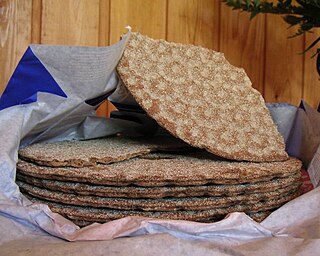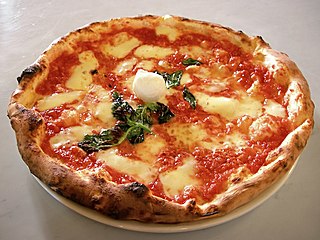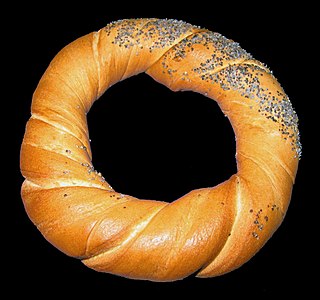
Upplandskubb is a Protected Designation of Origin and Ark of Taste bread traditionally produced in the province of Uppland in Sweden. It requires long fermentation and long baking in a bain-marie. It is often served at Christmas time.

Upplandskubb is a Protected Designation of Origin and Ark of Taste bread traditionally produced in the province of Uppland in Sweden. It requires long fermentation and long baking in a bain-marie. It is often served at Christmas time.
Upplandskubb is traditionally produced in the province of Uppland in Sweden. [1]
Oldest known recipes date to the 19th century from Älgesta farm in Husby-Ärlinghundra parish. [2] [3] Although a traditional food, the bread did not receive the Upplandskubb name until sometime in the 1920s when a Stockholm woman, Elisabet Langenberg, came across it and became interested. [3]
The bread is traditionally made from rye and wheat flours. [4] The dough is typically fermented for three hours or more and baked for over four hours. The bread is unique in Sweden as it is baked by being boiled in a bain-marie, which keeps it from forming a crust; [4] [3] no other boiled bread is known in Sweden. [3]
The bread is then to be left to sit after baking for at least a day and then cut, making it savory and rich. [2] The finished product is moist and sticky with a small crumb and a crumbly texture. [4] [3] Flavors are sweet and sour rye. [4]
It is cut into four vertical pieces which are cut crosswise into quarter-circle slices. [3] The bread is typically served with cured herring, lard or onion. It is commonly served at Christmastime. [4] [3] The bread keeps well. [3]
This bread was registered for a Protected Designation of Origin designation in the European Union in 2014; [5] [6] [7] the designation was granted in 2021. [1] The designation requires the dough to be made of locally-produced flours. [3] It has been taken on board the Ark of Taste by Slow Food. [3]

Bread is a staple food prepared from a dough of flour and water, usually by baking. Throughout recorded history and around the world, it has been an important part of many cultures' diet. It is one of the oldest human-made foods, having been of significance since the dawn of agriculture, and plays an essential role in both religious rituals and secular culture.

Sourdough or sourdough bread is a bread made by the fermentation of dough using wild lactobacillaceae and yeast. Lactic acid from fermentation imparts a sour taste and improves keeping qualities.

A bagel is a bread roll originating in the Jewish communities of Poland. Bagels are traditionally made from yeasted wheat dough that is shaped by hand into a torus or ring, briefly boiled in water, and then baked. The result is a dense, chewy, doughy interior with a browned and sometimes crisp exterior.

Dough is a thick, malleable, sometimes elastic paste made from grains or from leguminous or chestnut crops. Dough is typically made by mixing flour with a small amount of water or other liquid and sometimes includes yeast or other leavening agents, as well as ingredients such as fats or flavorings.

Spätzle ( ), or nokedli in Hungarian, are a type of Central European egg noodles typically served as a side for meat dishes with sauce. Commonly associated with Swabia and Alsace, it is also found in the cuisines of southern Germany and Austria, Switzerland, Hungary, Vojvodina, Slovenia, Lorraine, Moselle and South Tyrol.

Crispbread is a flat and dry type of bread, containing mostly rye flour. Crispbreads are lightweight and keep fresh for a very long time due to their lack of water. Crispbread is a staple food and was for a long time considered a poor man's diet.

Rugbrød is a very common form of rye bread from Denmark. Rugbrød usually resembles a long brown extruded rectangle, no more than 12 cm high, and 30–35 cm wide, depending on the bread pan in which it is baked. The basic ingredient is rye flour which will produce a plain or "old-fashioned" bread of uniform, somewhat heavy structure, but the most popular versions today contain whole grains and often other seeds such as sunflower seeds, linseeds or pumpkin seeds. Most Danes eat rugbrød every day.

Ukrainian cuisine is the collection of the various cooking traditions of the people of Ukraine, one of the largest and most populous European countries. It is heavily influenced by the rich dark soil (chornozem) from which its ingredients come, and often involves many components. Traditional Ukrainian dishes often experience a complex heating process – "at first they are fried or boiled, and then stewed or baked. This is the most distinctive feature of Ukrainian cuisine".

Rye bread is a type of bread made with various proportions of flour from rye grain. It can be light or dark in color, depending on the type of flour used and the addition of coloring agents, and is typically denser than bread made from wheat flour. Compared to white bread, it is higher in fiber, darker in color, and stronger in flavor. The world's largest exporter of rye bread is Poland.

Tatar cuisine is primarily the cuisine of the Volga Tatars, who live in Tatarstan, Russia, and surrounding areas.

Bread is a staple food of Finland. It is served with almost every meal and many different types are produced domestically.

Neapolitan pizza, also known as Naples-style pizza, is a style of pizza made with tomatoes and mozzarella cheese. The tomatoes must be either San Marzano tomatoes or pomodorino del Piennolo del Vesuvio, which grow on the volcanic plains to the south of Mount Vesuvius. The cheese must be mozzarella di bufala campana, a protected designation of origin cheese made with the milk from water buffalo raised in the marshlands of Campania and Lazio in a semi-wild state, or fior di latte, a cow's milk mozzarella created according to the procedure for which it was registered as a traditional speciality guaranteed (TSG). Pizza napoletana is a TSG product in the European Union and the United Kingdom, and the art of its making is included on UNESCO's list of intangible cultural heritage.
Bread is a staple food throughout Europe. Throughout the 20th century, there was a huge increase in global production, mainly due to a rise in available, developed land throughout Europe, North America and Africa.

Dumpling is a broad class of dishes that consist of pieces of cooked dough, often wrapped around a filling. The dough can be based on bread, wheat or other flours, or potatoes, and it may be filled with meat, fish, tofu, cheese, vegetables, or a combination. Dumplings may be prepared using a variety of cooking methods and are found in many world cuisines.

An obwarzanek krakowski is a braided ring-shaped bread that is boiled and sprinkled with salt and sesame or poppy seeds before being baked. It has a white, sweetish, moist and chewy crumb underneath a crunchy golden-brown crust. Traditionally sold from street carts, it is a popular snack in the Polish city of Kraków, where it has the status of a regional food with protected geographical indication. It is closely related to, but distinct from, bagels, bubliks and pretzels.

Tangzhong, also known as a water roux or yu-dane is a paste of flour cooked in water or milk to over 65 °C (149 °F) which is used to improve the texture of bread and increase the amount of time it takes to stale.

Limpa is a sweet Scandinavian rye bread, associated with Swedish cuisine. The bread is known in Swedish as vörtbröd/vörtlimpa. It is a yeast-leavened spice loaf, sweetened with brown sugar and molasses which comes in a large variety in regard to whether or not butter-enriched, and which spices are being used. Traditional bread spices are anise, caraway, fennel seeds, and bitter orange.
Cuccalar is a typical bread from the Valle dei Mocheni in the Autonomous Province of Trento. Once widespread throughout the valley, today it is produced almost exclusively in the municipality of Palù del Fersina; it is protected as a prodotto agroalimentare tradizionale and is also listed in the Ark of Taste.